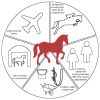A Review on Equine Influenza from a Human Influenza Perspective
- PMID: 35746783
- PMCID: PMC9229935
- DOI: 10.3390/v14061312
A Review on Equine Influenza from a Human Influenza Perspective
Abstract
Influenza A viruses (IAVs) have a main natural reservoir in wild birds. IAVs are highly contagious, continually evolve, and have a wide host range that includes various mammalian species including horses, pigs, and humans. Furthering our understanding of host-pathogen interactions and cross-species transmissions is therefore essential. This review focuses on what is known regarding equine influenza virus (EIV) virology, pathogenesis, immune responses, clinical aspects, epidemiology (including factors contributing to local, national, and international transmission), surveillance, and preventive measures such as vaccines. We compare EIV and human influenza viruses and discuss parallels that can be drawn between them. We highlight differences in evolutionary rates between EIV and human IAVs, their impact on antigenic drift, and vaccine strain updates. We also describe the approaches used for the control of equine influenza (EI), which originated from those used in the human field, including surveillance networks and virological analysis methods. Finally, as vaccination in both species remains the cornerstone of disease mitigation, vaccine technologies and vaccination strategies against influenza in horses and humans are compared and discussed.
Keywords: epidemiology; equine; horses; human; influenza; vaccination.
Conflict of interest statement
The authors declare no conflict of interest.
Figures



Similar articles
-
Equine Influenza Virus and Vaccines.Viruses. 2021 Aug 20;13(8):1657. doi: 10.3390/v13081657. Viruses. 2021. PMID: 34452521 Free PMC article. Review.
-
Whole inactivated equine influenza vaccine: Efficacy against a representative clade 2 equine influenza virus, IFNgamma synthesis and duration of humoral immunity.Vet Microbiol. 2013 Mar 23;162(2-4):396-407. doi: 10.1016/j.vetmic.2012.10.019. Epub 2012 Oct 24. Vet Microbiol. 2013. PMID: 23146168
-
Equine Influenza: Epidemiology, Pathogenesis, and Strategies for Prevention and Control.Viruses. 2025 Feb 21;17(3):302. doi: 10.3390/v17030302. Viruses. 2025. PMID: 40143233 Free PMC article. Review.
-
Refinement of the equine influenza model in the natural host: A meta-analysis to determine the benefits of individual nebulisation for experimental infection and vaccine evaluation in the face of decreased strain pathogenicity.Vet Microbiol. 2017 Nov;211:150-159. doi: 10.1016/j.vetmic.2017.10.010. Epub 2017 Oct 10. Vet Microbiol. 2017. PMID: 29102112
-
Protection, systemic IFNgamma, and antibody responses induced by an ISCOM-based vaccine against a recent equine influenza virus in its natural host.Vet Res. 2008 May-Jun;39(3):21. doi: 10.1051/vetres:2007062. Epub 2008 Feb 7. Vet Res. 2008. PMID: 18252187 Clinical Trial.
Cited by
-
Evidence that HA-G228S and PB2-D153V mutations upon viral growth of H3N8 influenza virus are associated with severe pathogenesis in human infections.Influenza Other Respir Viruses. 2023 Jun;17(6):e13169. doi: 10.1111/irv.13169. Influenza Other Respir Viruses. 2023. PMID: 37380173 Free PMC article. No abstract available.
-
First Molecular Detection and Epidemiological Analysis of Equine Influenza Virus in Two Regions of Colombia, 2020-2023.Viruses. 2024 May 24;16(6):839. doi: 10.3390/v16060839. Viruses. 2024. PMID: 38932133 Free PMC article.
-
First Reported Circulation of Equine Influenza H3N8 Florida Clade 1 Virus in Horses in Italy.Animals (Basel). 2024 Feb 12;14(4):598. doi: 10.3390/ani14040598. Animals (Basel). 2024. PMID: 38396566 Free PMC article.
-
Equine Influenza Virus: An Old Known Enemy in the Americas.Vaccines (Basel). 2022 Oct 14;10(10):1718. doi: 10.3390/vaccines10101718. Vaccines (Basel). 2022. PMID: 36298583 Free PMC article. Review.
-
Assessment of Equine Influenza Virus Status in the Republic of Korea from 2020 to 2022.Viruses. 2023 Oct 23;15(10):2135. doi: 10.3390/v15102135. Viruses. 2023. PMID: 37896912 Free PMC article.
References
-
- Tong S., Li Y., Rivailler P., Conrardy C., Alvarez Castillo D.A., Chen L.M., Recuenco S., Ellison J.A., Davis C.T., York I.A., et al. A Distinct Lineage of Influenza A Virus from Bats. Proc. Natl. Acad. Sci. USA. 2012;109:4269–4274. doi: 10.1073/pnas.1116200109/-/dcsupplemental/sapp.pdf. - DOI - PMC - PubMed
Publication types
MeSH terms
Substances
Grants and funding
LinkOut - more resources
Full Text Sources
Medical

